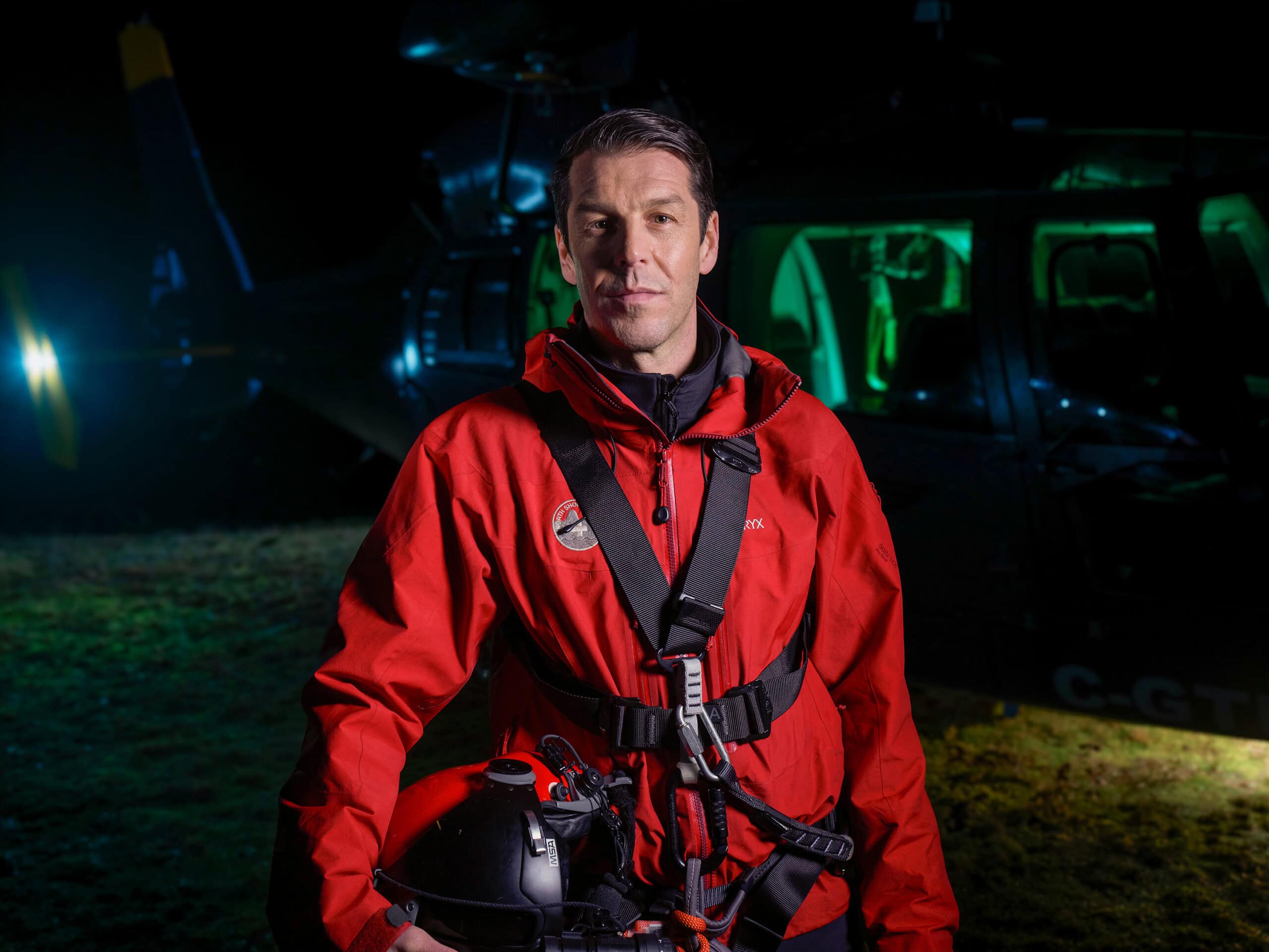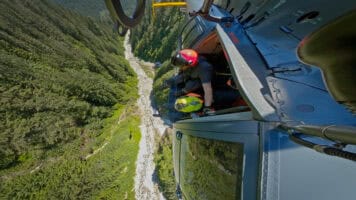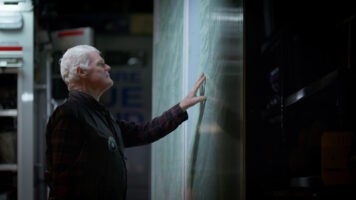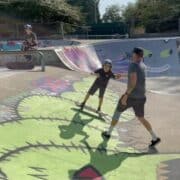After breaking Knowledge Network records, both North Shore Rescue and Silvapark Films are back with a new season of Search and Rescue: North Shore debuting May 28. The five-part docuseries takes place throughout the North Shore and Squamish highlighting the dedicated volunteers that are on duty 24/7/365.
Real impacts
Promising a look into the lives of Canada’s busiest search and rescue team, the second season of Search and Rescue: North Shore brings viewers along through the highs and lows facing local volunteers traversing through and over the mountains surrounding Lynn Valley. The first season released in 2020 was a massive success. It was an easy decision for all involved to invest the time and effort to offer a second season.

Mike Danks
When Jenny Rustemeyer and Grant Baldwin approached North Shore Rescue to document the local volunteer group they weren’t the first. With offers for longer format movies to lengthy reality TV, NSR Team Leader Mike Danks said it was clear the Silvapark Films team had something others didn’t: a respect for patient care priority and a comprehensive understanding of all the obstacles they would face.
“Our biggest concern was that it would not affect our response in any way,” said Danks, a LynnValley local, who was also recently appointed chief of the District of North Vancouver Fire Rescue Services. “They came and trained with us and showed us they had the skills to come along and not impact us in any sense. I think it’s important for people to understand how incredible it is that they captured the footage they did. We didn’t wait for them at all. We were moving as quickly as we possibly could and they were able to stay with us or get a head to capture that footage.”
The unforgiving terrain and weather, difficult for NSR, pulls no punches at the small crew filming their work.
“We have rescues that last multiple days and they are trying to keep GoPros running and the batteries going in conditions where it was -20, -30°C. Our main focus is not to keep those cameras going. We are doing what we need to do and they are doing what they need to do to capture the footage.”
The first season proved that all that effort is well worth it.
“We had an overwhelmingly positive response from everyone that saw it,” said Danks. “They really stressed the importance of lessons learned and seeing what happens behind the scenes and seeing the impact of these calls have on not only our mental wellbeing but the impact they have on our families as well.
“When they talked about doing season two it was a no-brainer. We also had a large increase in community support and that also reflects on other teams in the province as well – which was huge.”
Apart from gratitude and surprise that the “professional-grade” service providers are volunteers, one of the most beneficial results has been an increase in donations. The program showcased many of the practical challenges for all of British Columbia volunteer search and rescue groups. The increase in donor funding inspired by the series had noticeable ripple effects throughout the province.
 “The impact it had on donations to – not just with us but groups around the province – we didn’t hesitate to jump into season two.”
“The impact it had on donations to – not just with us but groups around the province – we didn’t hesitate to jump into season two.”
For Baldwin – who also became a resource member for NSR after filming season one helping support rescues using drones – one of the most important impacts is showcasing the efforts of the group whose members each give an average of 600 hours a year to prepare and rescue those in need. It is a perspective the subjects (the people being rescued) are also supportive of and makes them willing to share the potentially worst day of their lives so publicly.
“It often surprises the subject that we are filming because they don’t realize they’re volunteers. A lot of people still don’t know that,” said Baldwin.
There are a lot of vulnerabilities and tragedies captured. In some cases the subjects have found great value in viewing the footage after the fact, said Baldwin.
“They know they are lost or injured. They don’t understand what’s happening on the side of the rescue they don’t understand how the call comes to them. They don’t understand maybe why it took so long to get there or there are a lot of moving pieces and I think it’s helpful to see how it came together from the rescuers’ perspective.”
Season two
It was an interesting time to shadow NSR, said Baldwin. At the time of filming season two they were in the process of getting approvals for their night vision flying and coincidentally a wealth of photos and historical NSR records were found.
“You’ll learn more about Mike Danks, who’s team leader, his dad and his role on the team. You’ll learn more about some of the tech stuff that’s coming out with the team and also what’s available to the public in terms of hiking technology,” said Baldwin. “There are some technical rescues involving base jumpers, paragliders, and some of them are pretty intense as well.”
 It captures a very impactful period for Danks and his family. His father is fighting what will likely be a terminal diagnosis of cancer.
It captures a very impactful period for Danks and his family. His father is fighting what will likely be a terminal diagnosis of cancer.
“It captures a lot about my dad. He joined in the early 70s. He is the reason I joined the team,” said Danks. “Right now he is fighting a battle with cancer and will probably not survive much longer. He is in this and he has this legacy. It’s hard for me because I see his declining health as the series goes on.”
Baldwin and his team know much of the first season was shared with viewers of all ages. He advises pre-watching to make sure it’s suitable for everyone in your family. It was important to the film crew that they were accurate about the tragedy and personal risk volunteers face.
“There’s definitely some dramatic spectrum in this series, and it’s something you have to consider but we don’t shy away from that because we want to show what SAR goes through. We want to show how they deal with traumatic rescues as well. If we just dodged around that, then the conversation doesn’t happen about the mental health of the rescuers as well.”
Prioritizing health
The effects of such intense volunteer work have significant impacts on NSR members. The group has evolved over the years to understand and work to support each other.
 “I think times have changed, in the 10-year period I have been I have been the team leader. There has been a shift in how first responders look out for each other – to share it and not wear it,” said Danks. “NSR is exposed to a tremendous amount of trauma. I would almost argue that it is more than you see with police and fire because the calls we are going to are very, very significant. When you are in mountainous terrain the consequences are very high in those circumstances.
“I think times have changed, in the 10-year period I have been I have been the team leader. There has been a shift in how first responders look out for each other – to share it and not wear it,” said Danks. “NSR is exposed to a tremendous amount of trauma. I would almost argue that it is more than you see with police and fire because the calls we are going to are very, very significant. When you are in mountainous terrain the consequences are very high in those circumstances.
“Now we recognize we need to be more strategic with our responses so we can reduce the number of people who are exposed to that [risk and that trauma]. Not many people are aware that through covid our call volume spiked and a lot of those calls we were going to were suicides. Those were people who were 16-30 years old. They were going up to the mountains and jumping off cliffs or jumping in rivers or they were finding an isolated spot and they were overdosing on drugs. Those are calls we are responding to and we have a whole diverse group of people who aren’t used to seeing that – like accountants. We take the time to talk about that in this series and telling that story helps us cope with that and hopefully it helps others talk about it.”
When it comes to local viewers of the series who live, work and play in the mountains on the North Shore Danks hopes viewers gain an understanding of the wilderness that is accessible after a short hike from a downtown bus stop.
“The goal is to increase everyone’s awareness of preparedness and to shed light on the North Shore mountains are not just what you see from the downtown core. When you get to the North side of those mountains they are more remote areas without cell coverage. The game changes very, very quickly and you need to know how to navigate mountain terrain and let someone know where you are going and when you will be back and be prepared for changing conditions.
“You get to see little snippets of people going through those journeys and need help. It’s not to say that every rescue is preventable. That is not the case. No one goes out there planning to have a bad day,” said Danks. “It’s an opportunity to see the impact of some of the families that supported us that have lost a loved one. They have left a legacy that supports the North Shore community and you can see how that is paid back.
“And to be honest. I am getting a bit older and my emotions run pretty high. You get to see something happen in this series that shows how someone’s life was lost and it was paid back to multiple younger adults who made some pretty big mistake but they were saved because of that legacy.”
Season two of Search and Rescue: North Shore debuts on Knowledge Network May 28th at 8 pm. It will also be available for online viewing.
Looking for more?
There’s always something fun and exciting happening in Lynn Valley. Check out our Community Events Calendar or learn more about Local Activities, Mountain Biking or Hiking and Walking Trails.


